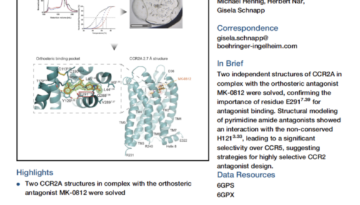Biophysical Assessment of Target Protein Quality in Structure‐Based Drug Discovery
leadXpro CEO Michael Hennig contributes a chapter about the progress of structure biology in drug discovery

leadXpro CEO Michael Hennig contributes a chapter about the progress of structure biology in drug discovery

Two independent structures of CCR2A in complex with the orthosteric antagonist MK-0812 were solved, confirming the importance of residue E2917.39 for antagonist binding. Structural modeling of pyrimidine amide antagonists showed an interaction with the non-conserved H1213.33, leading to a significant selectivity over CCR5, suggesting strategies for highly selective CCR2 antagonist design.



The paper reports an efficient method to generate multiple co-structures of the A2A G protein-coupled receptor (GPCR) with small-molecules from a single preparation of a thermostabilised receptor crystallised in Lipidic Cubic Phase (LCP)

The authors demonstrate that XFEL structure determination has matured to reality and point out the many advantages of the technology: Unmet brilliance and focus, femtosecond pulses and low/no radiation damage and measurement at room temperature allow structure determinations of challenging systems like membrane proteins, investigation of time-resolved ligand binding, new structural insights due to room temperature and full automation of crystal diffraction experiments.

We demonstrate that serial millisecond crystallography at a synchrotron beamline equipped with high-viscosity injector and high frame-rate detector allows typical crystallographic experiments to be performed at room-temperature.

A technology feature by Nature Methods’ technology editor Vivien Marx about free electron lasers to comment on the opening of the European X-ray Free Electron Laser (EuXFEL) in Hamburg, Germany.

A review by CEO Michael Hennig that discusses challenges and opportunities for biophysical methods in drug discovery.